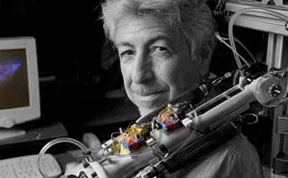video part 1
view at youtube or download video
video part 2
view at youtube or download video
Interacting, exploring, and working with humans, the new generation of robots being developed will increasingly touch people and their lives, in homes, workplaces, and communities, providing support in services, entertainment, education, manufacturing, personal health care, and assistance. This presentation focuses on the ongoing effort to develop human-friendly robotic systems that combine the essential characteristics of safety, interactivity, and performance with emphasis on (i) new design concepts and novel sensing modalities; (ii) multi-point compliant whole-body control strategies; and (iii) human-inspired behaviors through synthesis of human motion and skills.
In human-friendly robot design, our effort has focused on the development of intrinsically safe robotic systems that possess the requisite capabilities and performance to interact and work with humans. The design concept is based on a hybrid actuation approach that consists of biomimetic pneumatic muscles combined with small electric motors. The flexible muscles and the lightweight mechanism allow for human safety, while the electric motors compensate for the slower dynamics and nonlinearities of the pneumatics. This concept was shown to significantly decrease the inherent danger of robotic manipulators, as measured in terms of the reflected mass perceived at the point of impact. Safety is further enhanced by the addition of robot skin to provide impact reduction and tactile sensing capabilities for advanced sensor based behaviors.
The ability to physically interact with, and effectively manipulate in, human environments represents a major challenge for robots with complex human-like structures. Inspired by human behaviors, we have developed a unified whole-body task-oriented control framework that addresses dynamics in the context of multiple tasks, multi-point contacts, and multiple constraints. The performance and effectiveness of this approach have been experimentally validated on various robots. The new framework provides a multi-task prioritized control architecture allowing the simultaneous execution of multiple objectives in a hierarchical manner, analogous to natural human motion.
Initially motivated by the desire to emulate human movement and to endow robots with human-like movement characteristics, our extensive study of human musculoskeletal system has brought insights and results that proved extremely valuable in human biomechanics. Understanding human motion is a complex procedure that requires accurate reconstruction of movement sequences, modeling of musculoskeletal kinematics, dynamics and actuation, and suitable criteria for the characterization of performance. These issues have much in common with the problems of articulated multi-body systems studied in robotics research. Building on methodologies and techniques developed in robotics, a host of new effective tools have been established for the synthesis of human motion. These include efficient algorithms for the simulation of musculoskeletal systems, novel physio-mechanical criteria and performance measures, real-time tracking and reconstruction of human motion, and accurate human performance characterization. These developments are providing new avenues for exploring human motion -- with exciting prospects for novel clinical therapies, athletic training, character animation, and human performance improvement.

